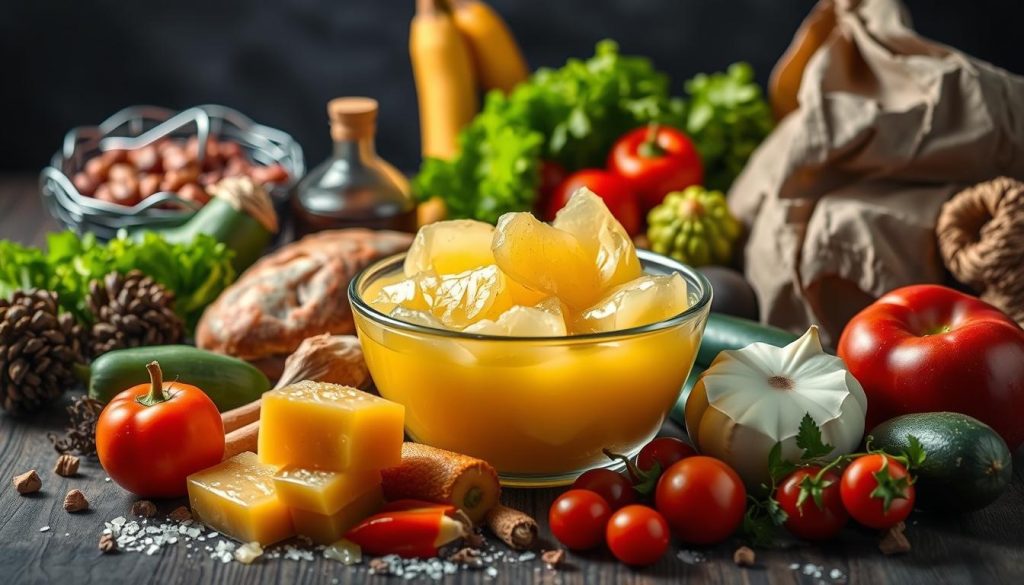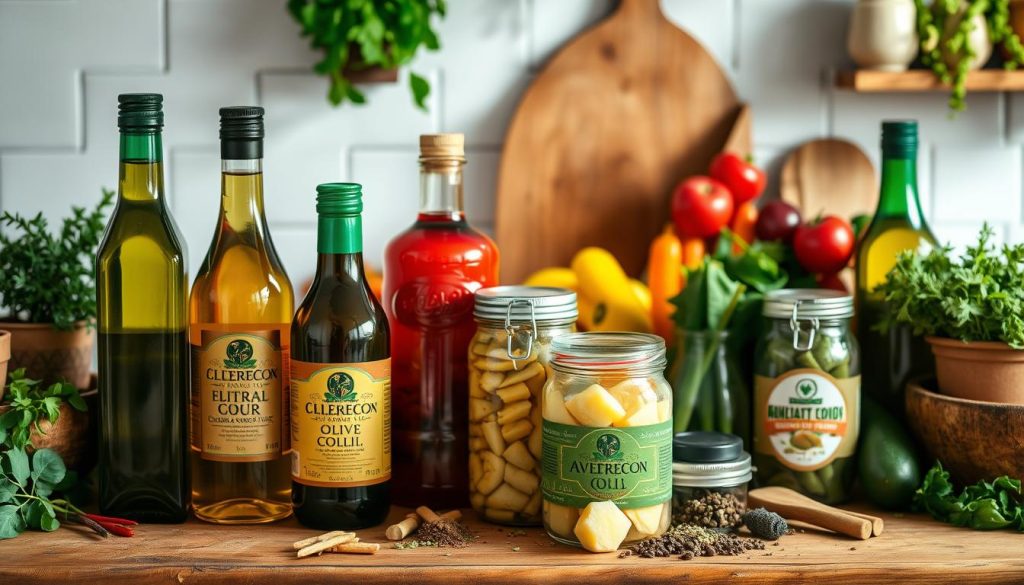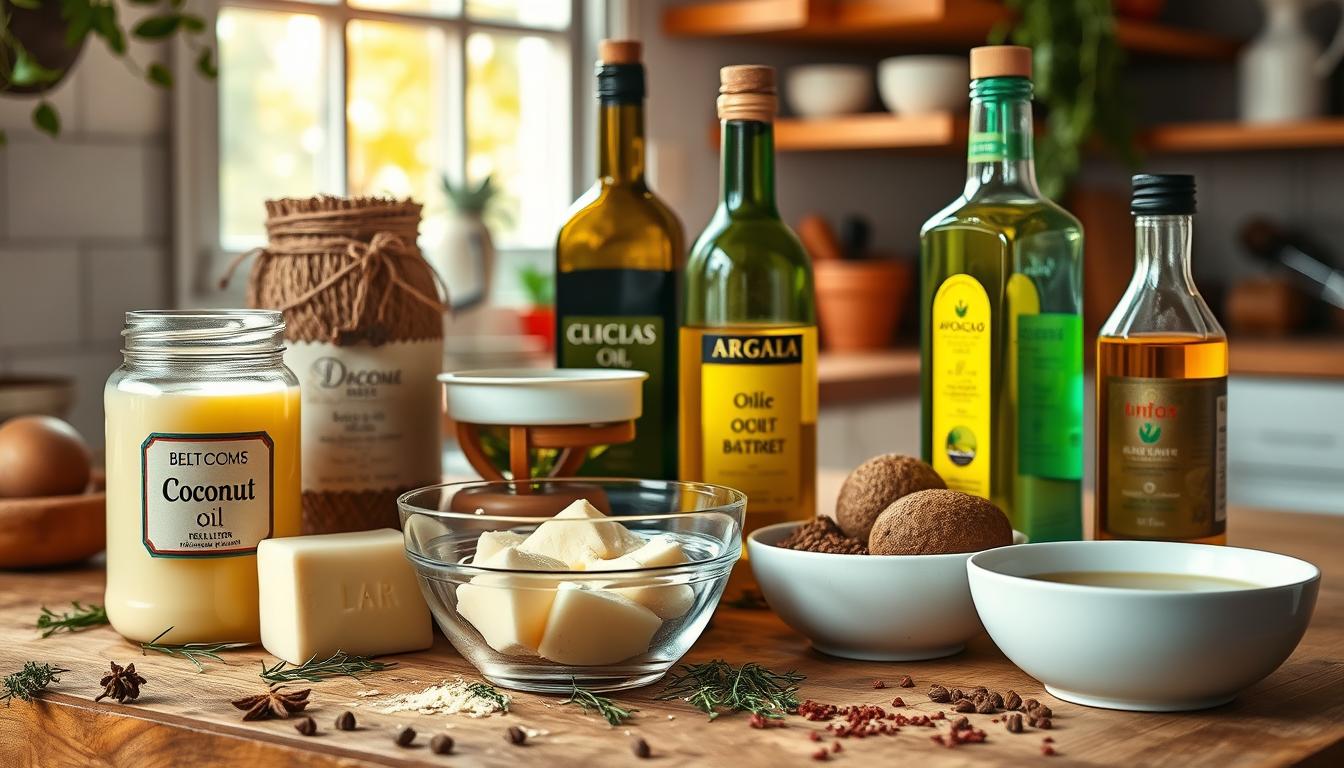Beef tallow was once a favorite cooking fat. But, health worries have led many to look for alternatives. This guide will show you top substitutes for beef tallow, covering their uses, tastes, and health effects.
You’ll learn about five great options: lard, schmaltz, ghee, and coconut oil. Each has its own benefits and works well with different cooking styles. Whether you’re on a keto, paleo, or Whole30 diet, you’ll find healthy oils that fit your needs.
Let’s explore these alternatives together. This way, you can make smart choices for your cooking.
Understanding Beef Tallow
Beef tallow is a cooking staple that’s gaining fans for its unique taste and uses. It comes from the rear fat of cattle and has a long history in cooking. Knowing what beef tallow is can make your cooking better and open up new recipe ideas.
What is Beef Tallow?
Beef tallow is a type of rendered fat known for its high smoke point. This makes it great for frying and sautéing. It stays stable at high heat, helping you get crispy foods without burning.
It also has vitamins A, D, E, and K. These vitamins are good for your health, helping with vision, immune function, and skin health.
Common Uses of Beef Tallow
Beef tallow is special because of its unique qualities. It’s used in many ways:
- Frying foods to get a crispy, golden texture, perfect for fries and pastries.
- Greasing cookware, especially cast iron skillets, to ensure easy food release.
- Enhancing the flavor of stews and sauces with a hearty, savory quality.
- Incorporating into baked goods for a rich taste and tender texture.
- Using in traditional recipes from various global cuisines, adding a unique touch.
Beef tallow is also used in non-culinary items like soap and candles. Its versatility and flavor make it a great choice for anyone looking to improve their cooking. It’s a standout option in the world of cooking oils.
Health Concerns with Beef Tallow
Beef tallow is a tasty and versatile cooking fat. It’s great for frying because it has a high smoking point. But, it’s high in saturated fats, which can be a health concern.
Saturated Fat Content
Saturated fats add flavor and texture to our food. But eating too much of them can increase cholesterol levels. This is why some people worry about the health risks of beef tallow.
Some people think beef tallow is good in small amounts. But, health experts often suggest using it with caution. They recommend eating less saturated fat and more unsaturated fats instead.
Choosing to use beef tallow means considering its high saturated fat content. Experts say to be careful and think about other options, especially if you have health issues or dietary restrictions.
| Type of Fat | Saturated Fat Content (grams per tablespoon) | Health Considerations |
|---|---|---|
| Beef Tallow | 12 | Moderation recommended due to potential heart disease risk. |
| Lard | 5 | Lower in saturated fats, can be a healthier alternative. |
| Butter | 7 | Rich in saturated fats, consume sparingly. |
| Ghee | 8 | Offers high smoke point with lower lactose content. |
| Coconut Oil | 13 | Contains medium-chain triglycerides, but should be used carefully. |

Exploring the Beef Tallow Alternative Guide
Looking for alternatives to beef tallow? You’ll find many options that fit different diets and tastes. From plant-based oils to animal fats, each offers unique flavors and health perks. Knowing these alternatives can boost your cooking and meet your health goals.
Plant-Based Alternatives
Plant-based cooking oils are a great choice for those avoiding animal fats. Here are some favorites:
- Coconut oil: It’s loved for its rich taste and health benefits, thanks to its medium chain fatty acids.
- Avocado oil: It has a high smoke point and a nice taste, making it versatile for many dishes.
These vegan options are perfect for plant-based diets or anyone looking to cut down on saturated fats. They make cooking healthier without sacrificing flavor.
Animal Fat Substitutes
Prefer animal fats? Lard and schmaltz are great substitutes for beef tallow. They keep the traditional taste and texture:
- Lard: Made from pig fat, it’s similar to beef tallow in taste and texture, making it great for cooking.
- Schmaltz: Rendered chicken fat, it has a milder taste that can enhance many dishes while being a solid choice.
These animal fat substitutes offer the savory taste you might want in your cooking. They also fit various dietary needs. Whether you go for plant-based oils or animal fats, there are plenty of ways to make your meals tasty and healthy.

Top Substitutes for Beef Tallow
Exploring alternatives to beef tallow reveals several options with unique flavors and benefits. These substitutes can improve your cooking, especially for specific textures or tastes in dishes.
Lard: Flavor and Versatility
Lard is a versatile fat that closely matches beef tallow in texture and taste. It excels in baking and frying. The benefits of lard include adding a rich flavor to pastries and savory dishes.
With various lard cooking uses, it can make everything from pie crusts to sautéed vegetables better. Lard has about 37% saturated fatty acids, perfect for achieving a golden-brown finish.
Schmaltz: A Unique Flavor Profile
Schmaltz, rendered chicken fat, has a distinct flavor that boosts many meals, especially in Jewish cuisine. Its uses for schmaltz go beyond frying; it can also enrich vegetables or be a base in savory dishes.
The chicken fat benefits include a mild yet complex flavor. This adds depth and satisfaction to comfort foods.
Ghee: High Smoke Point and Nutty Flavor
Ghee, clarified butter, is great for frying at high temperatures because of its high smoke point. Its rich, nutty flavor is perfect for many cuisines, especially Indian. Cooking with ghee offers health benefits like a longer shelf life and being lactose-free.
Many enjoy ghee’s versatility for sautéing and baking, expanding their cooking skills.
Coconut Oil: A Healthier Option
Coconut oil is solid at room temperature and similar to beef tallow. It has health benefits like medium-chain fatty acids that may reduce inflammation. Cooking with coconut oil allows for flexibility in flavor.
Unrefined versions have a strong coconut taste, while refined options are neutral. This makes it suitable for both sweet and savory recipes.
| Substitute | Flavor Profile | Cooking Methods | Smoke Point (°F) | Health Benefits |
|---|---|---|---|---|
| Lard | Rich and savory | Baking, frying | 370 | Higher in vitamin D, good for lowering LDL cholesterol |
| Schmaltz | Mild and flavorful | Frying, roasting, sautéing | 375 | Contains healthy fats from chicken |
| Ghee | Nutty and rich | Frying, sautéing, baking | 485 | Longer shelf life, lactose-free |
| Coconut Oil | Neutral to coconut flavor | Baking, frying, sautéing | 350 (refined 400) | Contains healthy fatty acids, may reduce inflammation |
How to Choose the Right Substitute
Choosing the right cooking fat is key to making your dish taste better. Think about how each fat fits into your recipe’s flavor. Some fats, like coconut oil, have strong tastes. Others, like lard or ghee, are more subtle. Knowing this helps pick fats that work well with your ingredients.
Flavor Profiles to Consider
When you replace beef tallow, remember the different flavors. Consider these:
- Beef Tallow: Rich, beefy flavor that enhances meat dishes.
- Lard: Similar to beef tallow but slightly milder.
- Ghee: Nutty flavor ideal for Indian cooking and sautés.
- Coconut Oil: Sweet, tropical taste that can overshadow other flavors.
- Shortening: Flavor-neutral, making it a versatile choice for baked goods.
It’s important to think about flavor and health when cooking. Beef tallow is best for dishes where beef flavor is important. For lighter or vegan recipes, something like shortening or vegetable oil might be better.
Cooking Methods and Temperature Compatibility
Knowing how to cook with different fats is crucial. Different fats can handle heat differently. Here’s a look at some common cooking fats:
| Fat Type | Smoke Point (°F) | Flavor Profile | Best Uses |
|---|---|---|---|
| Beef Tallow | 400 | Rich and Savory | Deep frying, roasting |
| Lard | 370 | Mild | Baking, frying |
| Ghee | 485 | Nutty | Sautéing, Indian cuisine |
| Coconut Oil | 350 | Tropical | Baking, light frying |
| Shortening | 360 | Neutral | Baking, thickening |
Choosing the right fat for your cooking method is important. For frying, use fats like ghee or beef tallow. For sautéing, fats with different flavors work well. Always choose based on your cooking method and desired taste.
Conclusion
Looking into beef tallow alternatives can make your cooking better and healthier. You can choose from animal fats or plant-based options. This guide helps you pick the best fats for your meals, keeping them tasty and nutritious.
Beef tallow is great for high-heat cooking because it has a smoke point of 400°F. But, you can also use ghee and coconut oil for similar benefits. Knowing what each fat offers lets you pick the best one for your diet and taste.
Choosing the right fat is key to healthier cooking. It affects both the taste and your health. By using the right alternatives, you’re on your way to making delicious, healthy meals that fit your lifestyle.
Source Links
- https://thecoconutmama.com/6-best-beef-tallow-substitutes/
- https://www.healthline.com/nutrition/lard-substitute
- https://pumpkincreekranchco.com/blogs/the-beef-blog/beef-tallow-vs-lard-pros-and-cons-explained?srsltid=AfmBOorFVZaKrp03H8s4su2_EUKQ1KGcY0Ouqdu0Jb-9mbEaYKUksQd1
- https://onaturelle.co/blogs/news/beef-tallow-explained?srsltid=AfmBOoqbugMW7duVxk71QnAxr1EFvaRfF90yepfxhLnqDCkNappO4g2y
- https://plumcreekwagyubeef.com/blogs/news/beef-tallow-back-to-basics-with-beef-fat?srsltid=AfmBOopXvxmGZ3z5mfONVnLTA1O_dkQaHFsvo32ptyKHqoworCHlQ7y-
- https://www.healthline.com/health-news/beef-tallow-moisturizer-tiktok-trend
- https://www.thechefandthedish.com/post/all-about-beef-tallow-a-classic-fat-in-a-modern-resurgence
- https://www.theatlantic.com/health/archive/2024/12/beef-tallow-kennedy-cooking-fat-seed-oil/680848/
- https://onaturelle.co/blogs/news/beef-tallow-explained?srsltid=AfmBOoo4COn_hmAHhv_gZysKuzD4VVYwc9Vd5dl4p5H9wgeJO0RSLGV4
- https://parkercountybeefcompany.com/blogs/news/the-ultimate-guide-to-beef-tallow-uses-top-benefits-and-applications
- https://www.soapmakingforum.com/threads/best-sub-for-tallow.84193/
- https://pumpkincreekranchco.com/blogs/the-beef-blog/beef-tallow-vs-lard-pros-and-cons-explained?srsltid=AfmBOorBOPp35vvd0CjbZdbl_NWoeqJFR2Y15AZC2ALWN-esPEJWOq2c
- https://discover.texasrealfood.com/swap-and-savor/how-to-substitute-beef-tallow-for-shortening-in-frying
- https://www.themeatinnplace.com.au/we-compared-beef-tallow-vs-vegetable-oil-and-this-is-what-we-found-out/
- https://oneearthhealth.com/blogs/health-news/beef-tallow-vs-ghee?srsltid=AfmBOoq6qVpw9Vlpe9zdKd6wGYUKXNnacupIKAHjIL0RYSM_OOq1ALa7
- https://www.cookingwithtallow.com/blog/hhow-to-choose-between-beef-tallow-and-other-cooking-fats
- https://www.tallowmepretty.com/blogs/news/tallow-vs-plant-based-oils-a-comprehensive-skincare-comparison
- https://pmc.ncbi.nlm.nih.gov/articles/PMC9266241/
